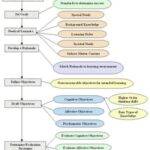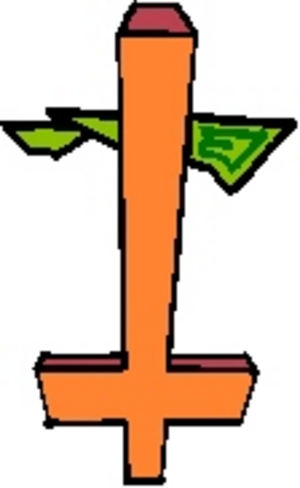Rationale
The purpose of this lesson is to familiarize students with a new concept: the nervous system. Students need to know the importance and function of the nervous system in order to understand its function and purpose within the systems of the human body. Students should learn about the nervous system because it is a part of their bodies.
Materials
Chart paper labeled with 5 phases of Synectics in different colors placed in order on a flip chart (first phase labeled with nervous system definitions)
Poster of the Nervous System
Markers
Tape or magnets to post charts on the board
Koosh ball
Organization: Whole Group Activity
Objectives
After a Synectics lesson on the nervous system, students will:
1. be more familiar with the nervous system;
2. generate an analogy for the nervous system;
3. compare and contrast the nervous system and an analogy.
Teaching Procedures
Motivation
Hold up a Koosh ball and after gaining student attention, throw the ball to one of the students. The student will catch the ball. Ask the students, “How did he/she know to catch the ball just now?” Let a few students respond. “He/she ‘saw’ the ball coming? How did he/she know to catch the ball before it hit him/her? Think about it.” Students will respond. “Okay, let’s pretend this ball is a potato. I just pulled this potato out of the oven. I forgot to put on my oven mitt. How do you suppose it will feel? Let’s pass the ball around as if it is a hot potato.” Give the ball to students and watch as they pass it around quickly. Ask students, “How did the potato feel? How do you know it’s hot? That’s right, you can feel it. Does anyone know what part of our body helps us to react to things such as a ball coming right at us or something that is hot to the touch? That’s right, it is our brain and our nerves. They are a part of our Nervous System. What do you think your brain is doing for you right now?” Possible answers: allowing us to listen and respond, controlling our heartbeat, controlling our breathing, allowing us to sit up without falling over. “Great answers! Well, today we are going to learn a little bit about nervous system. So, let’s use our brains to listen, think and remember!”
Phase I: Substantive Input
Have first chart showing nervous system definitions and a picture/poster of the nervous system. Ask students, “Does anyone know anything about the nervous system that they would like to share?” Allow students to share ideas with the whole group and give positive feedback. “Our new unit will be on the nervous system. The nervous system is just one of the many systems of our human bodies.” Here are some very general and brief terms I’d like to share with you about the nervous system as an overview to our new unit.” Share the following terms with the class. You might have them copy them down or give them a copy of them later for their notebooks.
Nervous System: a control system made up of the brain, spinal cord and nerves.
Brain: control center of the nervous system.
Cerebrum: the part of the brain that functions in learning, memory and reasoning.
Spinal Cord: a structure that carries messages between the brain and the other parts of the body.
Cerebellum: the part of the brain that is involved in muscle coordination and body balance.
Medulla: the part of the brain that controls many involuntary functions necessary for life.
Reflex: a quick, automatic response to a stimulus.
Receptor: a structure that receives a stimulus from the environment.
Phase II: Direct Analogy
Move Phase I chart over to the board where all students can see it and come back to chart to begin Phase II. “To help you become more familiar with the nervous system, we are going to compare it to something you all are more familiar with, the computer.” All of you have had a vast amount of experience at school with computers. So, let’s talk about computers. I’d like for you to tell me what you know about computers. Describe a computer and its’ functions to me.” Students will respond by brainstorming and naming what they know about computers. Other questions to ask to elicit more responses could include: “What other parts of the computer can you name? What other functions does a computer have?” Write down student responses on the Phase II chart. Possible student responses might include: hard drive, software, monitor, CPU, mouse, keyboard, modem, Internet, email, memory, cables, printer, speakers, Pentium chip, stores information, communication, word processing, databases, spreadsheets, World Wide Web, etc.
Phase III: Personal Analogy
Move Phase II chart over to the board next to Phase I chart and return to the chart for Phase III. “You all are computer experts! Okay, now that we have compiled a list of what we know about computers, we are going to move on and we are going to become the computer. Close your eyes. Pretend you are a computer. Think about what it would feel like to be a computer. Okay, open your eyes. Tell me, how does it feel to be a computer?” Encourage and praise students’ responses. Write all the responses on the chart, until students have no more responses or until you have enough responses. Possible student responses might include: used, smart, needed, overworked, quick, tired, fast, slow, etc.
Phase IV: Comparing Analogies
Move Phase III chart over to the board with the others and come back to chart for Phase IV. “Okay, we talked about what we know about computers. Then, we became the computer. Now we are going to compare the computer to the nervous system. You can look back at the chart with the nervous system information and the chart with things we know about computers to help you. I want you to tell me what these two things (the nervous system and the computer) have in common. What similarities can you find between the nervous system and the computer?” Write all student responses on the chart. Encourage and praise responses. If students need help, using leading questions such as: “Can you think of parts of a computer that are similar to parts of the nervous system? Are there things that both the nervous system and that computers need? Are there things that both do?” Possible student response might include: both have memory, both can learn, both can forget (computer deletes), both can communicate, both need energy, both can send and receive messages, both can change, both can be damaged, both can do math, etc.
Phase V: Explaining Differences
Move Phase IV chart over and come back to Phase V chart. “You all came up with some super examples of similarities between the nervous system and the computer. Now, that we have discussed the similarities, let’s move on the discuss the differences. Not everything about computers and the nervous system are alike. What are some things that are different? Write all the student responses on the chart. If students are having difficulty, help them with leading questions such as: “How do the the two differ in appearance? How do they differ in needs? How about functions?” Possible student responses might include: the computer is non-living and the nervous system is a part of a living organism, the computer uses electricity and the nervous system needs oxygen, the computer memory can be added but costs money and our memory is vast and free, computers can do many tasks at once without thought and our brain does not allow us to do a whole lot at once, the computer has no imagination, the computer is faster than a brain, the computer is easy to fix or replace whereas the brain is not. “Wonderful responses! Are there any other differences or similarities that you’d like to add? I hope by comparing and contrasting the nervous system with a computer was a helpful tool for you to better understand the nervous system.”
Phase VI: Generating Analogy
Move Phase V chart over and come back to Phase VI chart to discuss the final phase. “You all did a super job participating in today’s lesson! For homework tonight, you are going to read about the nervous system in your science textbook. Then you will choose something (an analogy) that you can compare and contrast to the nervous system just like we did today with the computer. ” Read the directions for generating analogy to the students and answer questions that may arise. Possible ideas for student analogies might include: telephone or cell phone, television, satellite, etc.
Directions for Analogy:
Read the chapter in your science text on the nervous system. Construct your own direct analogy to the nervous system. Explore the similarities and the differences between the nervous system and your analogy. Then, write an essay about your analogy. Your essay should contain four paragraphs: an introduction paragraph about the nervous system, a paragraph describing your analogy, a paragraph describing the similarities between the two, and a paragraph describing the differences between the two. Make sure students write down the assignment.
Closure of the Lesson
“Today I introduced some new information to you. What did we learn about today? That’s right, the nervous system. And what did we do to make this strange new information more familiar? Right, we compared it to something more familiar to us, the computer. That is called an analogy. We discussed the similarities and the differences between the nervous system and the computer to help us better understand the nervous system.”
Evaluation/Assessment
The objectives will be assessed by:
1. observing students and their responses during all phases;
2. collecting the written essay to check for construction of an analogy to the nervous system and to check for compare and contrast of analogy to the nervous system.






